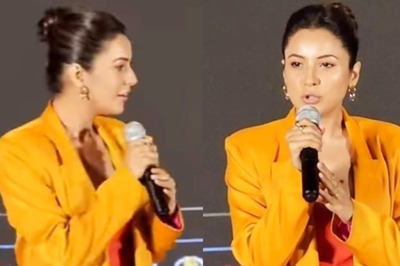
views
Gone are the days when it used to take years to build a narrative. As we move into the age of artificial intelligence (AI), it only takes a moment to do so, thus blurring the boundary between reality and hoax. As T.S. Eliot avers, “Between the idea and the reality, between the motion and the act falls the shadow”. Generative AI has intruded workspaces, organisations, healthcare, education sectors, and even our democracy. What sounded fictitious a few years back has become the quotidian reality of our lives.
To put it another way, reality has become a metric that can be constructed and, therefore, manipulated by the politicking of technology. How else could one understand the bombardment of more than a million deepfakes in the recently concluded Indian elections?
It is no less a strange paradox that season 3 of the Panchayat web series and the elections for the 18th Lok Sabha coincided in India. Situating the “dekh raha hai Binod” within this election context, one could understand the deepfake provenance of our present-day democratic setup. Just as Bhushan in the web series constantly uses this phrase both as a provocative, scandalous, and populist tool to manipulate the common people in the village, and to set his agenda right, in the same way, the deepfake tools used by the Opposition was an election propaganda to gain mileage in the Lok Sabha.
For example, a deepfake video of Amit Shah was widely circulated in which he was purportedly seen hinting at the end of reservation rights of the SCs, STs, and OBCs, and scrapping the Constitution. During this election, we also witnessed other deepfake videos, such as one where actor Ranveer Singh speaks in a disparaging tone about PM Modi, while the video displays the Congress party symbol with the text: ‘Vote For Nyay, Vote For Congress’. Even the dead politicians were resurrected through the generative power of artificial intelligence, which sums up the shock-and-awe effect of the deepfake age on Indian democracy in recent times.
To understand the “dekh raha hai Binod” syndrome, one need only observe how a single man like Bhushan convincingly uses narrative to obfuscate the line between fact and fiction He defends and promotes the idea of democracy, while challenging the political stance of the current village panchayat head. Just like the Opposition, Bhushan did not taste victory, however, his rhetorical ammunition positions him as an effective storyteller. This mirrors how the Congress party, despite losing the national election, enthusiastically wove and amplified narratives of both their victory and the triumph of democracy.
Perhaps the Congress found solace in the belief that deepfake videos contributed to reducing the ruling party’s seats in the Lok Sabha. Maybe it sought to construct a narrative of its strong comeback. Both perspectives are crucial in grasping the dangers posed by the rampant proliferation of generative AI, which has eroded the sanctity of Indian democracy. As rightly pointed out by Santishree Pandit, “What stood out this time was how these narratives ended up targeting democracy and its electoral processes directly—a dangerously alarming trend for both Indian democracy and society.”
The moot point, however, is that, unlike the reel life of web series, the real India has not one but several Bhushans, and that should be enough to gauge the implications of the deepfake phenomenon. In our populist era, the underlying premise of the “dekh raha hai Binod” syndrome underscores the rise of nationalist fervour, exacerbated by the diminishing ability of our populace to discern fact from fiction. This syndrome highlights that popularity often equates to populism, signalling a dangerous disconnect from our reflective spaces while entrusting our destinies to the manipulative powers of artificial intelligence.
It is apparent that the nation was swayed by the syndrome and the deepfake videos shared by the Opposition, with equal vigour and ignorance. Put this way, the deepkfake of AI is a manifestation of the syndrome, which seems to have become a mandatory prologue to our electoral processes and practices, thus animating and diminishing what can be counted as real. While our eyes and minds grapple to distinguish between human and machine intelligence, our ears are stuffed with the wax of populist voices and the juggernauts of artificial reality.
With the rise and updates in technology, we are surrounded by new challenges which demand human interventions to tackle them. Assigning the task of creation and intervention to machine learning is bound to have ramifications for the entire civilisation, which neither multinational corporations nor political parties can fathom at this juncture. Because social media platforms and AI depend on a set of codes, and, therefore, the codes can be designed in a way that impedes our thinking spaces, even our ability to control the machines. Precisely why PM Modi expressed his concerns about this detrimental trend plaguing our democracy.
India’s 18th Lok Sabha election is just the tip of the iceberg for our leaders and the world to understand the stigmatizing effects of generative AI. The shift to the deepfake age also signifies the crude reality that the obverse of popularity is populism in our present-day democracy, underpinned as it is with the ‘Dekh raha hai Binod’ syndrome. For the moment, it looks like this syndrome will continue to speak to our populace unless the government comes out with stringent laws, applicable across parties and the nation. If the deepfake becomes the quotidian reality of our democracy, the inevitable corollary of it would be public fate being decided by the amount of lies one could tell and perpetuate. Doesn’t that ring a bell?
Om Prakash Dwivedi is an author and columnist. Views expressed in the above piece are personal and solely those of the author. They do not necessarily reflect News18’s views.

















Comments
0 comment